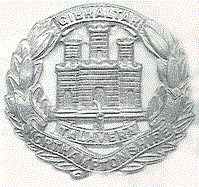

RADFORD, Rowland
Private 18556
NORTHAMPTONSHIRE REGIMENT 5TH BATTALION
who died on
Thursday, 10th May 1917
Rowland was born in Abberton and raised by his Grandmother, Mariam in the village. They lived opposite the old school building in Abberton. Unfortunately when he died his aged Grandmother lost her source of support and had to go to the Workhouse to live. She died in 1918 in her 90s. She had come originally from Little Clacton and married James a farm labourer from Abberton. There were a number of Radfords living here in 1901. At Abberton there was ; Charles 44, Edward 21 and Fanny 50. There was also a brother Percy 3 years older than Rowland. There were 11 uncles, aunts and cousins in Langenhoe see the section on Arthur Radford
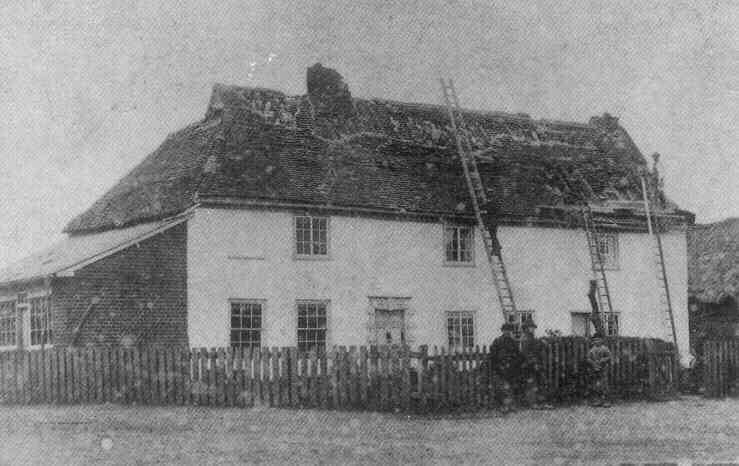
It is believed that Rowland lived in the right hand one of the three cottages of what is now "White House", (where a man stands on the roof). This picture was taken in 1884 just after the major earthquake, which badly damaged most of the buildings in Langenhoe and Abberton.
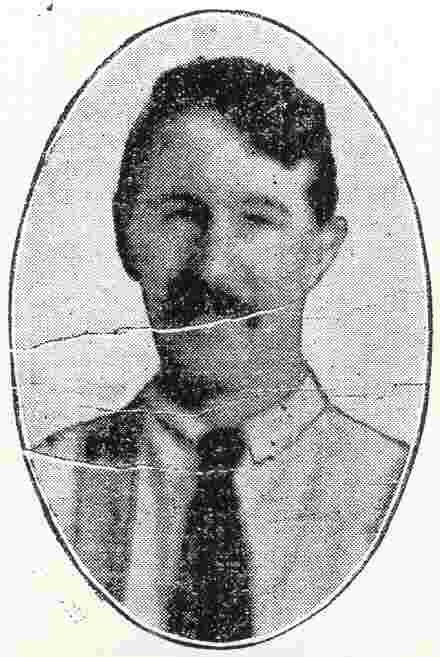
shelf mark1459
This picture was taken by a nurse at Saint Thomas' Hospital in London, when he was suffering from the bullet wound to the knee.
Rowland had been unlucky before the war to be struck by lightning. He had the scars of the burns on his back. He enlisted at Colchester. He was placed in the 5th (Service) Battalion the Northamptonshire Regiment (Pioneers). This was one of the three Service Battalions, along with the 6th & 7th, which were formed in August 1914 from Lord Kitchener's first 100,000 volunteers. The 5th Battalion joined the 12th (Eastern) Division with 12 other Kitchener Infantry Battalions. From his medal listings we know he went to France on the 29th September 1915.
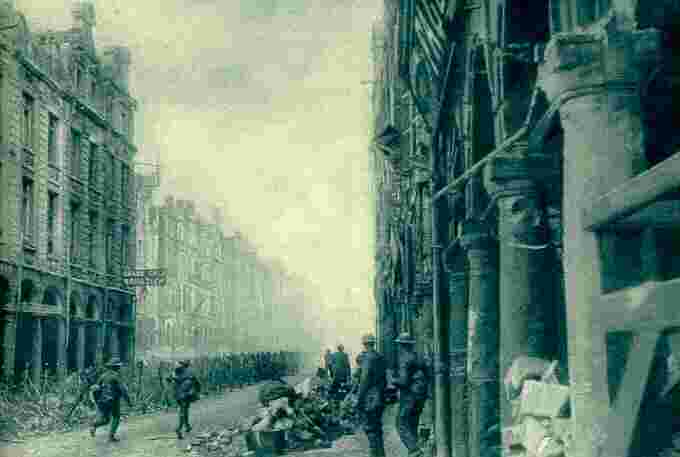
Arras during the battle in April 1917
The action in which Rowland died was during the 3rd Battle of Arras, which began with an attack on Vimy Ridge on the 9th April 1917. This attack was in advance of the general offensive against Ypres. Sir Douglas Haig, the commander of the British Expeditionary Force needed to secure this area to protect his flank from counter-attack by the Germans. After 2 months bitter fighting the Allied forces captured Gavrell, Guemappe and positions east of Lens. They advanced 7,500 yards in the first few days and 12 Division alone captured 20 German officers, 12,000 men and 41 guns.
During the previous November & December the Battalion had been based at Berneville engaged on trench improvements. The role of the pioneers was digging trenches, so that ammunition and food could reach the front line and casualties brought back in relative safety. In addition the were engaged in the front line: strengthening the defences, creating sleeping quarters etc.. Thus they were often exposed to enemy artillery, machine guns & snipers. Preparation for the Arras offensive continued through March, where they were working in the cellars of Arras. They also created a tunnel under the Cambrai road.

Hotel de Ville, Arras April 1917
The battle began on the 9th April and they were used as Assault Pioneers, cutting 5 communication trenches across what had previously been No-Man's Land to link with newly won positions. After 2 more days of intense fighting, the 5th were sent forward to a captured German strong-point at Feuchy Chapel redoubt, nearly 6000 yards in front of the British start line. Here they worked on consolidating the newly captured "Brown " line, which lay along the Arras- Cambrai road. This involved constructing 4 strong points. They suffered 11 wounded.
The Division was then rested until 23rd April. The Pioneers were often cheated of their rest periods, as there was a continual need to maintain the defences and they seldom could be spared. They returned to the line and were involved in supporting actions around Monchy. On May Day, an Officer and 11 men were wounded and 1 killed, when one of our own shells hit "C" Company. Over the next few days they continued in the line strengthening positions. It was in this period, Rowland and three other privates; Cox, Jackson and Stebbings, were killed
Rowland had been wounded twice before: once with a bullet to the knee & on the second time, with a severe shrapnel wound in the chest. He had been nursed back to health at Saint Thomas's Hospital, London before returning to France. It is not known in which actions he sustained his wounds, as his records have been lost. However, his Division, the 12th (Eastern) Division, fought in the Battle of Loos in 1915 and in 1916 at :-
The Battle of Albert (first phase of the Battle of the Somme)
The Battle of Pozieres (third phase of the Battle of the Somme)
The Battle of Le Transloy (eighth phase of the Battle of the Somme).
This was followed in 1917, with the First Battle of the Scarpe, which was the first phase of the Arras Offensive and Rowland's final Battle of Arleux. The Pioneers would have been involved each time, though due to his wounds, it is doubtful if Rowland was present at them all.
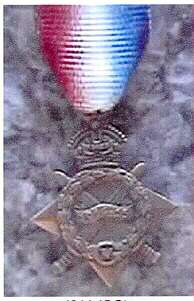
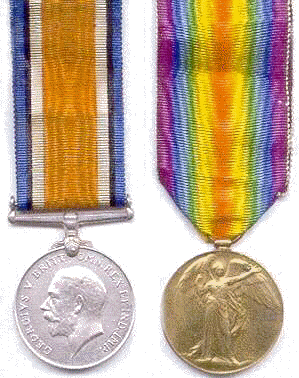
He was awarded ; The Allied Victory and British War Medals and the 1914-15 Star for France.
He is commemorated at the Arras Memorial, Pas de Calais, France in Bay 7. The Arras Memorial is in the Faubourg-d'Amiens Cemetery, which is in the Boulevard du General de Gaulle in the western part of the town of Arras. The Memorial commemorates almost 35,000 British, New Zealand and South African troops killed between Spring 1916 and 7th August 1918, who have no known grave.
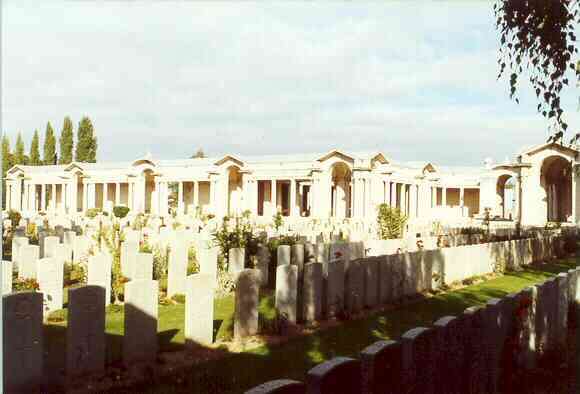
REFERENCES
Information obtained from The Commonwealth War Graves web site. www.
cwgc.org/There is a photo and obituary in the June 16th edition of the County Standard page 7. This is held on microfiche in the Colchester Library. We have kindly been given permission by the British Library to reproduce it here specifically for the Memorial website: shelf mark 1459
Information was also kindly supplied by The Northamptonshire Regiment Association & "Kitchener's Pioneers - The story of one Battalion formed from Kitchener's first 100,000 -August 1914" compiled by Geoffery Moore
The pictures of the medals were kindly provided by Worcestershire Medal Service Ltd.
The pictures of Arras are taken from the publication The Great War in 13 volumes (Publisher not given)
The picture of White House was kindly provided by the late Peter Wormwell.
10/26/02 last updated
**********************************************************
These pages are dedicated to the memory of the Fallen from the two World Wars, who lived in Abberton & Langenhoe.. Prepared by Saint Andrew's Parochial Church Council. November 11th 2000